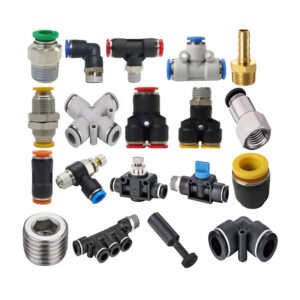The Function of Pneumatic Fittings
Pneumatic fittings are used to connect either single or multiple hoses with fitttings and can allow the user to easily change the connections in a system for an assortment of tubes or pipes.
What are pneumatic fittings used for?

Pneumatic power systems include any type of mechanized or automated process or machinery in which movement is driven by pressurized gas or compressed air. The most obvious counter-example here is hydraulic systems, where movement is driven by a liquid that is subjected to a similar compressive force in a sealed system.
“Pneumatic” specifically refers to the delivery of power by controlled movement of pressurized gas (including air). In any pneumatic system, the pressurized gas that drives the desired mechanism is usually delivered to where it is needed through a sealed network of rigid pipes, sturdy hoses, or lengths of flexible tubing.
The vast majority of these pipes are connected to each other and to various power supplies through a wide variety of pneumatic fittings, couplings, valves and adapters. Generally speaking, pneumatic fittings can be any type of connectors used to connect components or devices in sealed and pressurized dry air systems.
These systems and accessories are used today in a wide variety of industries and applications, from construction, assembly and production line setups to a wide variety of industrial machinery, hand tools and workbench equipment. In many work environments, the power provided by pneumatic systems is often more versatile, reliable, cost-effective and safer than equivalent units powered by various motors and actuators.
Types of Pneumatic Fittings
Push in Fittings (PT, R, BSPT, NPT)
Pneumatic Fittings, Plastic Push in Fittings (PT, R, BSPT, NPT) come in a variety of types, moulds and sizes to satisfy various tube demands. Accept metric and inch tube, and PT(R, BSPT), NPT thread.
Brass Push in Fittings
Full nickel plated brass push in fittings, also called brass push to connect fittings, made of forged brass (elbows, tees, banjos, union Y and cross)
Misting System Fittings
slip-locks misting system fittings, as the name describes, slip together and lock. In the misting industry these fittings are made of of nickel plated brass. The tubing used is high pressure nylon. The locking occurs under pressure. The greater the pressure the harder they lock.
Quick Couplings
Quick coupling with an automatic shut-off valve built in the socket is widely used to connect air and low pressure fluid lines.
More types
As a professional Pneumatic Fittings manufacturer and wholesaler in China,we provide full range of fittings at stable quality and competitive prices.Just get a Free Quote within today.
Pneumatic Fitting Connection Type
When purchasing connectors and adapters for this type of system, you will see many options, including a variety of different assembly methods and styles. The most common of these are:
Push-In Pneumatic Fittings
This model is designed with speed and ease of assembly/disassembly in mind, but they are also designed to provide a safe and secure connection. They are often capable of completely tool-free connection and disconnection between various pipes, pipes and tools; ideal for fittings that require frequent reassembly.
The most common push-fit fittings feature a collet or “grip ring” around the connection point through which the hose or pipe slides and then automatically clamps and secures the pipe. Push down on the collet with two fingers (or a quick release tool) to instantly disconnect the fitting from the pipe.
Push-fit fittings can be made of plastic or various metals. Plastics are often used in low pressure systems, while metal fittings may be required in high temperature applications or environments.
Tube to Tube Pneumatic Fittings
Tube-to-tube adapters are available in a variety of diameters, sizes and materials. They are used to join two lengths of pipe together and can be straight or angled, and different types of pipe can be selected to use a range of materials such as nylon, polyurethane or polyamide conduit.
Threaded Pipe Pneumatic Fittings
This type of fitting consists of tightening threads on the inner (inner) or outer (outer) edge of the connector that will be measured to mate with mating threads on the end of a length of hose or conduit.
Fittings sold with straight threads are designed to form a strong connection between parts, but do not necessarily create a hermetic seal on their own – this thread type requires an additional coat of sealant or a layer of Teflon tape for used in the application. Fittings with tapered threads should be airtight without additional coating or tape. In some work environments, sealants and coatings may cause corrosion or contamination, which may be necessary.
Threaded to Barb Air Fittings
This is usually a push-on fitting, where the hose or pipe is pushed onto the barbed end for an initial clamp, then a knurled nut is tightened around the pipe and barb to provide complete safety for connections used under air pressure.





